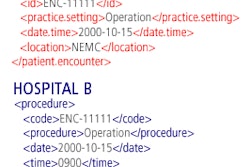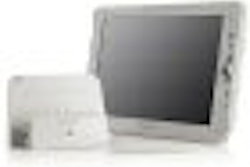PROVIDENCE, RI - It is quite common for a surgeon to seek the counsel of a radiologist during a procedure when he or she is looking for a suspicious lesion that was detected on a CT scan, but upon closer inspection is nowhere in sight.
Ultrasound gets the call to come to the OR immediately to show the surgeon the lesion's location and to help determine if biopsy or removal is the best course of action.
"When they request our help, it is usually to make a decision," said Dr. Steven Horii, a radiologist with the University of Pennsylvania Health System in Philadelphia. "About 30% of the time the surgical procedure is altered because of what we find in the OR."
Unfortunately, even the most altruistic of intentions comes at a price. "Intraoperative ultrasound is disruptive," Horii said, and causes havoc for both the surgical and radiology departments, as more steps and decisions are added to normal workflow patterns. With that issue in mind, he began to analyze workflow bottlenecks and how to solve them.
Speaking on the opening day of the Society for Imaging Informatics in Medicine (SIIM) 2007 annual meeting, Horii said a major issue is that surgery is delayed for a patient -- often anesthetized -- while the OR team waits for a radiologist to arrive with an ultrasound system, and, of course, time is money.
Precious seconds
"There are figures floating around that OR time is $1 a second," Horii added. "Waiting 15 minutes for radiology to show up is a problem. For radiology, it takes a radiologist and a sonographer out of the department. I'll come back and now there are nine patients waiting, because we were out of the office."
A radiologist must stop reading cases or halt teaching activities if he or she is in an academic center. The lack of reimbursement also is an issue for radiology. "If I spend two hours in the OR doing an intraoperative ultrasound on a liver," he said, "I am reimbursed for a portable ultrasound or biopsy guidance."
Horii also noted how the location of displays in the OR can have a negative impact on workflow. If the displays are several feet away from the procedure, both the radiologist and surgeon will have trouble viewing patient images and even may have to keep turning to see the monitor.
If the ultrasound PACS is not connected to a hospital's main PACS, the surgeon also will lose the benefit of the just-acquired images because of the missing network connection.
Possible solutions
One recommendation is to let the surgeons perform their own ultrasound exams, which is currently the policy for neurosurgeons at the University of Pennsylvania Health System. Whether surgeons are willing to go through the additional training for ultrasound is a question, however.
In addition, Horii cited the University of Pittsburgh where radiologists are credentialed in surgery and have limited privileges. "You won't let a radiologist take someone's appendix out, but they are certified to do work in the OR for image-guided procedures," he added. "For lengthy procedures, the radiologist is listed as a surgical assistant, because they are part of the team. Then, radiology can bill a surgical fee for their radiologist."
Display screens also can be centered in the OR on booms to give the surgical team and radiologist a better view of the images. "You wouldn't have to turn or lean in closer and worry about the sterility of the displays," he added.
Seamless network connections also can solve the problem of image transfer from one system to another problem.
There is no argument that surgeons and radiologists are willing to tolerate the negative impact on workflow due to intraoperative ultrasound because the importance of those studies remains paramount to patient care. Still, delays in surgery and "the interruption of typical workflow in radiology are the chief problems," Horii reiterated, "but I think (surgeons and radiologists) are amenable to technological and administrative solutions."
By Wayne Forrest
AuntMinnie.com staff writer
June 8, 2007
Related Reading
Radiologists may be better off taking hands-on approach to 3D workflow, April 30, 2007
PACS, IT help meet changing ultrasound workflow requirements, April 23, 2007
3D ultrasound offers efficiency improvements, March 29, 2007
Can ultrasound benefit from the rest of radiology? March 8, 2007
3D ultrasound brings efficiency gains, May 25, 2006
Copyright © 2007 AuntMinnie.com



















